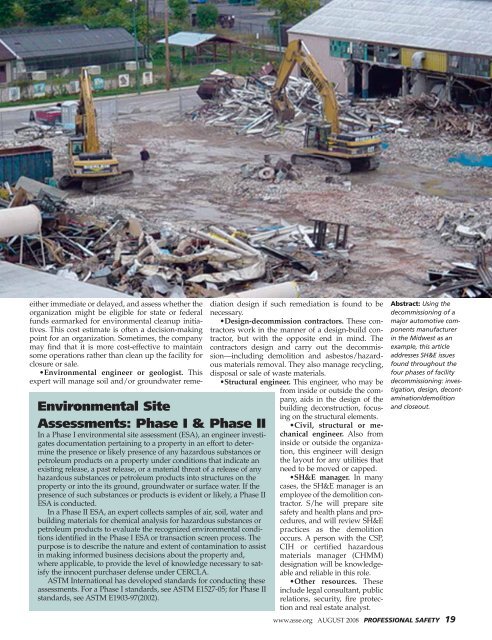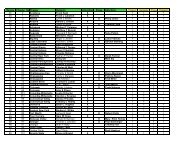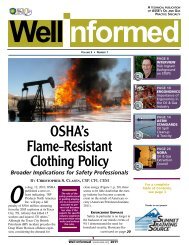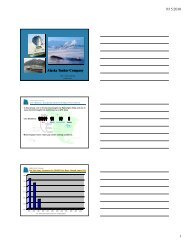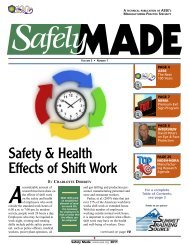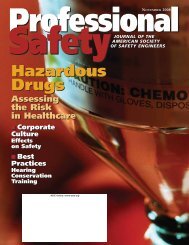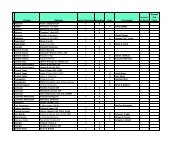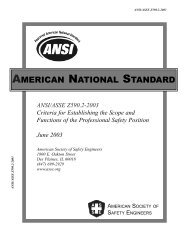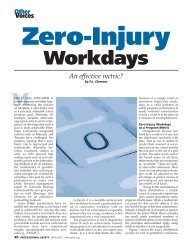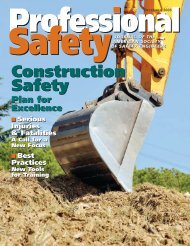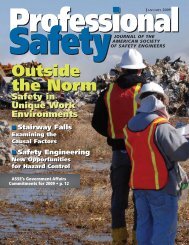<strong>Safety</strong> Management<strong>Safety</strong> ManagementFacilityDecommissioningA look at key SH&E considerationsBy Bryan Bailey and Craig GaleckaBBUILDING AN INDUSTRIAL EMPIRE is complicatedand time-consuming. An idea is born. A process isdesigned. A factory is built. As demand increases, somust production and, with it, facilities. As technologyadvances, managers employ new processes, materials,chemicals and machinery; new product linesaugment or replace the old ones. It takes power, rawmaterials, capital goods and infrastructure.When a company decides to close its doors, itsleaders can be faced with an unpleasant surprise:Shutting down an operation is nearly as complicatedas building it. In truth, the proper decommissioning <strong>of</strong>facilities or parts <strong>of</strong> facilities is important to the success<strong>of</strong> an organization’s plans for the site or property. Thedecision to close or substantially modify a facilityinvolves significant planning and risk assessment. Inaddition, the SH&E issues involved in this processmust be addressed. Failure to do so could have negativefinancial and legal consequences, and result innegative publicity. When a company or consultingfirm approaches a decommissioning, it is well advisedto consider SH&E throughout the four common phases<strong>of</strong> facility decommissioning: investigation, design,decontamination/demolition and closeout.Bryan Bailey, P.E., CHMM, is a projectmanager with LJB Inc. in Dayton, OH. His areas<strong>of</strong> practice include construction management,design-build and facility decommissioning. Heholds a bachelor’s degree in civil engineering, amaster’s degree in mechanical engineering andan M.B.A. Bailey is a pr<strong>of</strong>essional member <strong>of</strong><strong>ASSE</strong>’s Kitty Hawk Chapter.Craig Galecka, P.E., CSP, is an industry expertin environmental and safety compliance forLJB’s manufacturing, commercial and publicclients. He specializes in design and permittingprojects involving fall protection, hazardouswaste and confined spaces. Galecka holds abachelor’s degree in chemical engineering anda master’s degree in environmental engineeringfrom Michigan State University. He is apr<strong>of</strong>essional member <strong>of</strong> <strong>ASSE</strong>’s Lansing Chapterand a member <strong>of</strong> the <strong>Society</strong>’s EnvironmentalPractice Specialty.18 PROFESSIONAL SAFETY AUGUST <strong>2008</strong> www.asse.orgDecommissioningConsiderationsA decommissioning projectis complicated in nature. Because<strong>of</strong> this, many organizationswork with engineers andfirms well versed in the intricacies<strong>of</strong> the process. Decommissioningrequires an almostmicroscopic attention to detail,particularly those involvingsafety and health. Regulationsand safety standards are inplace to protect not just workers,but also the public and theenvironment. Applying thesemany recommendations andregulations can result in a safeand environmentally sounddecommissioning process.First, Build a TeamAs an organization approaches a decommissioning,it should assemble a knowledgeable team withthe skills and expertise needed to plan and executethe project in a way that serves the organization andall other stakeholders. Team members could includesome or all <strong>of</strong> the following, depending on the projectand type <strong>of</strong> facility:•Process or facilities engineer. This individual,typically from inside the organization, will assesscapital inventory and physical property.•Financial manager. This person may be frominside or outside the organization. S/he will determinepotential for reuse, sale or disposal <strong>of</strong> equipment,and evaluate the tax and financial implications<strong>of</strong> various closure options. This manager will alsowork with the process or facilities engineer to reportthe findings to the organization’s decision makers andother team members.•Tax consultant. This expert will help the companyanalyze the effects <strong>of</strong> its decommissioningdecisions on tax responsibilities. This individualmay be from inside or outside the organization. Itshould be noted that this aspect <strong>of</strong> decommissioningis <strong>of</strong>ten overlooked despite the fact that the financialimpact <strong>of</strong> such an oversight can be considerable.•Environmental consultant. Either from inside oroutside the organization, this individual will conductan environmental site assessment (Phase I ESA) todetermine the potential for contamination <strong>of</strong> soil orgroundwater. A Phase I ESA is conducted to determinewhether any potential areas <strong>of</strong> hazardous wastecontamination and/or environmental liabilities areassociated with a property.If necessary, the consultant will take samples todetermine the extent <strong>of</strong> contamination (Phase II ESA).A Phase II ESA is conducted if recognized environmentalconditions are identified during the Phase IESA; it involves collecting and analyzing soil and/orgroundwater samples to determine the extent <strong>of</strong>potential environmental contamination (see “EnvironmentalSite Assessments” sidebar on p. 19).The consultant will also evaluate process equipmentfor residual hazardous chemicals. If issues areidentified, s/he will estimate the cost <strong>of</strong> cleanup,
either immediate or delayed, and assess whether theorganization might be eligible for state or federalfunds earmarked for environmental cleanup initiatives.This cost estimate is <strong>of</strong>ten a decision-makingpoint for an organization. Sometimes, the companymay find that it is more cost-effective to maintainsome operations rather than clean up the facility forclosure or sale.•Environmental engineer or geologist. Thisexpert will manage soil and/or groundwater reme-Environmental SiteAssessments: Phase I & Phase IIIn a Phase I environmental site assessment (ESA), an engineer investigatesdocumentation pertaining to a property in an effort to determinethe presence or likely presence <strong>of</strong> any hazardous substances orpetroleum products on a property under conditions that indicate anexisting release, a past release, or a material threat <strong>of</strong> a release <strong>of</strong> anyhazardous substances or petroleum products into structures on theproperty or into the its ground, groundwater or surface water. If thepresence <strong>of</strong> such substances or products is evident or likely, a Phase IIESA is conducted.In a Phase II ESA, an expert collects samples <strong>of</strong> air, soil, water andbuilding materials for chemical analysis for hazardous substances orpetroleum products to evaluate the recognized environmental conditionsidentified in the Phase I ESA or transaction screen process. Thepurpose is to describe the nature and extent <strong>of</strong> contamination to assistin making informed business decisions about the property and,where applicable, to provide the level <strong>of</strong> knowledge necessary to satisfythe innocent purchaser defense under CERCLA.ASTM International has developed standards for conducting theseassessments. For a Phase I standards, see ASTM E1527-05; for Phase IIstandards, see ASTM E1903-97(2002).diation design if such remediation is found to benecessary.•Design-decommission contractors. These contractorswork in the manner <strong>of</strong> a design-build contractor,but with the opposite end in mind. Thecontractors design and carry out the decommission—includingdemolition and asbestos/hazardousmaterials removal. They also manage recycling,disposal or sale <strong>of</strong> waste materials.•Structural engineer. This engineer, who may befrom inside or outside the company,aids in the design <strong>of</strong> thebuilding deconstruction, focusingon the structural elements.•Civil, structural or mechanicalengineer. Also frominside or outside the organization,this engineer will designthe layout for any utilities thatneed to be moved or capped.•SH&E manager. In manycases, the SH&E manager is anemployee <strong>of</strong> the demolition contractor.S/he will prepare sitesafety and health plans and procedures,and will review SH&Epractices as the demolitionoccurs. A person with the CSP,CIH or certified hazardousmaterials manager (CHMM)designation will be knowledgeableand reliable in this role.•Other resources. Theseinclude legal consultant, publicrelations, security, fire protectionand real estate analyst.Abstract: Using thedecommissioning <strong>of</strong> amajor automotive componentsmanufacturerin the Midwest as anexample, this articleaddresses SH&E issuesfound throughout thefour phases <strong>of</strong> facilitydecommissioning: investigation,design, decontamination/demolitionand closeout.www.asse.org AUGUST <strong>2008</strong> PROFESSIONAL SAFETY 19


